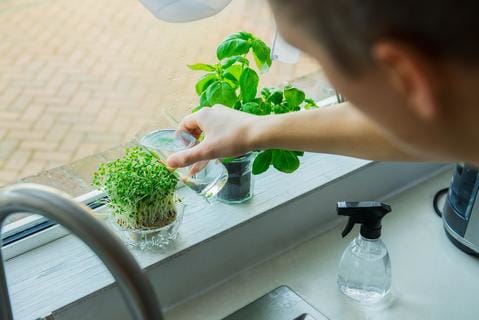Indoor gardening can be the perfect pick-me-up at any time of year, but it is particularly comforting when it gets cold outside and your backyard garden has gone dormant. Without much effort, windowsill gardens can provide bursts of freshness to your cooking, bright pops of color on cold days, and a cheerful reminder that you will be back out playing in the soil sooner than you think!
If you are like many Pinetree Garden Seed customers, bedding down your backyard garden brings a mix of emotions—gratitude for the bounty of the growing season behind you, a little bit of relief that the hard work of harvest is done, and a twinge of regret that the joys of gardening are going away for a time.
But they don’t have to! Why stop growing? A windowsill garden is a great way to get your fix when conditions won’t allow for outdoor gardening. Often overlooked by more serious home gardeners, the humble windowsill garden can give you all kinds of benefits: fresh flavors and fragrances for your kitchen creations, pretty blooms when the world outside feels barren, and restorative moments of mindfulness as you water or prune your plantings during the colder, darker days.
Look around your house for a sunny window—preferably south-facing, to soak up the most available rays—and start thinking about filling it with greenery and growth. With a few tips below, your humble windowsill garden can yield a surprisingly satisfying harvest!
Choose plants that can adjust to different levels of sunlight
No matter where you live, your windowsill garden will most likely get less light than your backyard garden beds. Plants that require full sun to thrive might not make it. To garner plantings that over-perform in window pots, choose seeds that can stand up to a little less sun.
Our gardening experts recommend microgreens, herbs, and edible flowers as fun indoor plantings that flourish with less light. Rotating pots in the windows now and then can also help straighten out seedlings and avoid that leggy look.
- Microgreens - Trendy yet timeless, these delicate profusions of delicious greens germinate quickly and easily and can be harvested almost immediately. And they are so pretty! Each tender green leaf is packed with nutrients and adds flavor and texture when scattered over sandwiches, salads, soups, quiches, and more.
- Herbs - You can always plant individual herbs (and find a detailed guide to windowsill herbs in a previous blog), or opt for one of our Herb Garden Kits. These will help you determine a group of multiple herbs, which could be planted in the same pot or tray. This creates a delightful variety of leaf shapes and colors and a rich blend of aromatics as well as “one-stop shopping” for cuttings while you are cooking.
- Edible Flowers - Another customer favorite that maximizes windowsill garden space is our Edible Flower and Herb Mix. If you enjoy designing creative planter gardens—mixing plant heights, foliage and flower colors, and textures to maximum effect—this is the mix for you. Every planter can produce its own edible arrangement of oregano, calendula, monarda, perilla, thyme, nasturtium, agastache, allium, borage, hyssop, chamomile, melissa, basil, parsley, and salvia.
- Thyme - Pinetree Garden Seeds sells several varieties of thyme, each with slightly different flowers, leaves, stem colors, and intoxicating aromas. Even if you only plant one pot on your kitchen windowsill, we think it should be thyme—easy to grow and oh so versatile.
Invest in high quality potting soil and planters with proper drainage
You can plant a windowsill garden in almost anything, from empty and washed plastic yogurt containers to handcrafted ceramic pots. The key is to make sure your planter has at least one hole for drainage, a saucer or plate to catch runoff and protect your windowsill from water damage, and a rich, nourishing potting soil in which to grow.
Water—but don’t overwater—your windowsill garden

How do you know when a windowsill planting is well-watered? While different plantings will have different tolerances (and your home’s humidity levels will also play a part), there are some good rules of thumb.
Weekly watering should be adequate for most indoor plants. If your home is particularly warm or dry—for instance, if your planting is in close proximity to a hearth or woodstove—you may need to water more frequently. Not sure if your plants are getting enough? Press your finger a couple centimeters into the potting soil to see if it is damp. Overwatering can stress or blight your seedlings so don’t overdo it.
Have pets? Have a plan to keep them out of your windowsill garden
Indoor garden pests are quite a bit more furry and lovable than outdoor garden pests, but they can be destructive just the same. Cats, in particular, can often be tempted by both the potting soil as well as the greens growing within them, and can make quite a sport of knocking over pots, or chewing on tender leaves. To avoid this, our gardening experts recommend planting a little pot of catnip to distract your curious cats, or spraying plants with hot pepper as a natural deterrent.
Have fun!
Remember forcing avocado pits as a kid? It is just as fun to do today. Somehow, stripping back to a few seeds and plants can reawaken the natural wonder of how simple and spectacular it is to watch something grow. Involve children, grandchildren, or good friends in planting and plant-tending. Photograph your most successful pots, or spend a quiet moment sketching them with colored pencils and watercolors. Share a few precious pots as gifts. Just like your backyard garden, one of the great harvests of a windowsill garden should be happiness.
Windowsill gardens are reminders to grow where you are planted and make the most of every sunny day, so start one today. Let us know your most successful windowsill garden plantings in the comments and keep us posted on your progress.


Nadja, yes Thyme can be brought inside too! We recommend a few days of bright but indirect light as the plants acclimate to indoor life. Sometimes the direct sun can be a bit abrasive with the sudden shift in atmosphere. Keep us posted!
I have basil growing right now but was just wondering if my pots of thyme can be brought in safely as well. I will bring them in today and see what else I can make room for amongst my house plants!
Sharon, you don’t need good windows sills!! Go to the cheapie furniture (goodwill, resaike, etc) stores and get a small/ narrow table place it front of your chosen window!! PERFECT!!
Thanks for these helpful tips!!!
Many years ago an older lady friend in Grand Lake, CO (8600 ft), gave me a couple fresh tomatoes in January. I was stunned. She took me to laundry room where 2 huge pots of tomato plants grew in old-fashioned laundry tubs under east window. Healthy as in short summer.
I’ve been near Monte Vista, CO (7600 ft) 33 years, back porch has south windows and deep sills. So I grow cherry tomatoes bred for pot growing (Red Robins always) a few peppers (for fun, do little), parsley and basil in 8" or 12" pot, seeded in summer. 3 are in west window. The herbs grow really well, every few weeks I clip then dry some for later use—put leaves on cookie sheets, oven to 170, then off, leave overnight.(if not perfect, reheat slightly and turn off next day.) Result: I almost never buy either in stores. I prefer Italian parsley and Genovese basil.
Tomatoes aren’t doing as well this winter, need to re-pot 3, but often harvest c. 500/winter or more (60-70 so far), plenty for 2 of us plus a couple friends. With decent water and fertilizer, they thrive nicely, have home-grown flavor unlike expensive store-bought ones—which saves lots of $. They produce in flushes, remove old leaves, sometimes cut back for regrowth, and watch for bugs. I learned to never bring in any from outside—got aphids and white flies 2x, awful to get rid of, so those planted in spring for winter remain indoors always.
If I had laundry tubs like Grace did I’d try big tomatoes, but those went away long back. By the way, my former splendid orange cat used to sun himself on a sill but never knocked over a plant. I’m retired but did this even while working full-time, doesn’t require much time to care for.
I hope this is helpful for others.